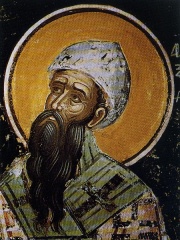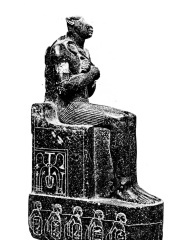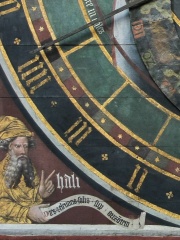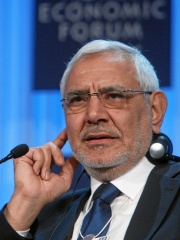



The Most Famous
PHYSICIANS from Egypt
This page contains a list of the greatest Egyptian Physicians. The pantheon dataset contains 726 Physicians, 5 of which were born in Egypt. This makes Egypt the birth place of the 27th most number of Physicians behind Iran, and Belgium.
Top 5
The following people are considered by Pantheon to be the most legendary Egyptian Physicians of all time. This list of famous Egyptian Physicians is sorted by HPI (Historical Popularity Index), a metric that aggregates information on a biography's online popularity.

1. Cyril of Alexandria (376 - 444)
With an HPI of 76.98, Cyril of Alexandria is the most famous Egyptian Physician. His biography has been translated into 60 different languages on wikipedia.
Cyril of Alexandria (Ancient Greek: Κύριλλος Ἀλεξανδρείας; Coptic: Ⲡⲁⲡⲁ Ⲕⲩⲣⲓⲗⲗⲟⲩ ⲁ̅ or Coptic: Ⲡⲓⲁⲅⲓⲟⲥ Ⲁⲃⲃⲁ Ⲕⲩⲣⲓⲗⲗⲟⲥ ⲡⲓⲥⲧⲩⲗⲗⲟⲥ ⲛ̀ⲧⲉ ⲡⲓⲛⲁϩϯ or ⲡⲓ̀ⲁⲅⲓⲟⲥ Ⲕⲓⲣⲓⲗⲗⲟⲥ; c. 376–444) was the Patriarch of Alexandria from 412 to 444. He was enthroned when the city was at the height of its influence and power within the Roman Empire. Cyril wrote extensively and was a major player in the Christological controversies of the late 4th and 5th centuries. He was a central figure in the Council of Ephesus in 431, which led to the deposition of Nestorius as Patriarch of Constantinople. Cyril is counted among the Church Fathers and also as a Doctor of the Church, and his reputation within the Christian world has resulted in his titles Pillar of Faith and Seal of all the Fathers. The Nestorian bishops at their synod at the Council of Ephesus declared him a heretic, labelling him as a "monster, born and educated for the destruction of the church". Cyril is well known for his dispute with Nestorius and his supporter, Patriarch John of Antioch, whom Cyril excluded from the Council of Ephesus for arriving late. He is also known for his expulsion of Novatians and Jews from Alexandria and for inflaming tensions that led to the murder of the Hellenistic philosopher Hypatia by a Christian mob. Historians disagree over the extent of his responsibility in this. Cyril tried to oblige the pious Christian emperor Theodosius II (AD 408–450) to himself by dedicating his Paschal table to him. Cyril's Paschal table was provided with a Metonic basic structure in the form of a 19-year lunar cycle adopted by him around AD 425, which was very different from the first Metonic 19-year lunar cycle invented around AD 260 by Anatolius, but exactly equal to the lunar cycle which had been introduced around AD 412 by Annianus; the Julian equivalent of this Alexandrian cycle adopted by Cyril and nowadays referred to as the "classical (Alexandrian) 19-year lunar cycle" would emerge a century later in Rome as the basic structure of Dionysius Exiguus’ Paschal table (AD 525). The Catholic Church did not commemorate Saint Cyril in the Tridentine calendar: it added his feast only in 1882, assigning to it the date of 9 February. Yet the 1969 Catholic Calendar revision moved it to 27 June, considered to be the day of the saint's death, as celebrated by the Coptic Orthodox Church. The same date has been chosen for the Lutheran calendar. The Eastern Orthodox and Byzantine Catholic Churches celebrate his feast day on 9 June and also, together with Pope Athanasius I of Alexandria, on 18 January. Cyril is remembered in the Church of England with a commemoration on 27 June. Western Rite Orthodox Christians within the Antiochian Western Rite Vicariate, which is under the auspices of the Antiochian Orthodox Christian Archdiocese of North America, celebrate the Feast of Saint Cyril of Alexandria on 28 January, which is when his Feast Day occurs in the Roman Martyrology.

2. Merit-Ptah (2700 BC - 2659 BC)
With an HPI of 67.68, Merit-Ptah is the 2nd most famous Egyptian Physician. Her biography has been translated into 27 different languages.
Merit-Ptah ("Beloved of Ptah") was thought to be a female chief physician of the king's court during the Second Dynasty of Egypt, c. 2700 BC. She was purportedly referred as such on an inscription left on her grave at Saqqara by her son. However, in recent times it has been argued that she most likely never existed, being a modern 1938 invention of Canadian feminist Kate Hurd-Mead. Jakub Kwiecinski, a historian at the University of Colorado, was cited by secondary source Newsweek arguing that the made-up story of Merit-Ptah exemplifies how "seemingly well-sourced Wikipedia articles" can mislead, and he cautioned against over-reliance on secondary sources.

3. Psusennes II (1100 BC - 945 BC)
With an HPI of 66.89, Psusennes II is the 3rd most famous Egyptian Physician. His biography has been translated into 32 different languages.
Titkheperure or Tyetkheperre Psusennes II [Greek Ψουσέννης] or Hor-Pasebakhaenniut II [Egyptian ḥr-p3-sb3-ḫˁỉ-⟨n⟩-nỉwt], was the last king of the Twenty-first Dynasty of Egypt.

4. Ali ibn Ridwan (988 - 1061)
With an HPI of 63.64, Ali ibn Ridwan is the 4th most famous Egyptian Physician. His biography has been translated into 22 different languages.
Abu'l Hassan Ali ibn Ridwan Al-Misri (Arabic: أبو الحسن علي بن رضوان بن علي بن جعفر المصري) (c. 988 - c. 1061) was an Arab of Egyptian origin who was a physician, astrologer and astronomer, born in Giza. He was a commentator on ancient Greek medicine, and in particular on Galen; his commentary on Galen's Ars Parva was translated by Gerardo Cremonese. However, he is better known for providing the most detailed description of the supernova now known as SN 1006, the brightest stellar event in recorded history, which he observed in the year 1006. This was written in a commentary on Ptolemy's work Tetrabiblos. He was later cited by European authors as Hali, Haly, or Haly Abenrudian. According to Alistair Cameron Crombie he also contributed to the theory of induction. He engaged in a celebrated polemic against another physician, Ibn Butlan of Baghdad.

5. Abdel Moneim Aboul Fotouh (b. 1951)
With an HPI of 52.58, Abdel Moneim Aboul Fotouh is the 5th most famous Egyptian Physician. His biography has been translated into 16 different languages.
Abdel Moneim Aboul Fotouh Abdel Hady (Arabic: عبد المنعم أبو الفتوح عبد الهادي, pronounced [ʕæbdelˈmenʕem abu lfʊˈtuːħ ʕæbdelˈhæːdi] or [ʕæbdelˈmonʕem]; born 15 October 1951) is an Egyptian physician, former student activist and politician. In 2011–2012, he ran for president of Egypt as an independent. He was formerly a leader of the Muslim Brotherhood in Egypt. He is known for his staunch opposition to the Sadat and Mubarak regimes as well as his openness towards people of different political ideologies, a subject of controversy among some supporters of Egyptian Islamist movements. Affiliated with the Muslim Brotherhood since the early 1970s, Abou al-Fotouh had been a member of the Brotherhood's Guidance Bureau from 1987 until 2009. In 2011, he formally quit all political work with the Muslim Brotherhood and resigned from its membership, following his decision to run for president in the presidential election in 2012. He is currently the secretary-general of the Arab Medical Union. He was arrested on 14 February 2018 upon his return from London following an interview he gave to Al Jazeera in which he criticised the rule of Abdel Fattah el-Sisi.
People
Pantheon has 5 people classified as Egyptian physicians born between 2700 BC and 1951. Of these 5, 1 (20.00%) of them are still alive today. The most famous living Egyptian physicians include Abdel Moneim Aboul Fotouh. The most famous deceased Egyptian physicians include Cyril of Alexandria, Merit-Ptah, and Psusennes II.
Living Egyptian Physicians
Go to all RankingsDeceased Egyptian Physicians
Go to all RankingsCyril of Alexandria
376 - 444
HPI: 76.98
Merit-Ptah
2700 BC - 2659 BC
HPI: 67.68
Psusennes II
1100 BC - 945 BC
HPI: 66.89
Ali ibn Ridwan
988 - 1061
HPI: 63.64

